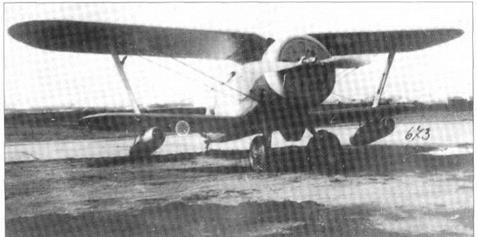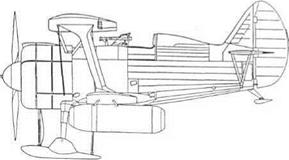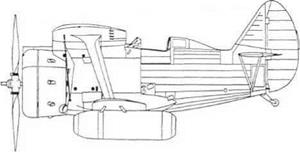Polikarpov I 152 DM 2 and M53/DM-4
Purpose: To test ramjet engines and investigate performance of aircraft thus boosted.
Design Bureau: Joint effort by A Ya Shcherbakov (aircraft) and Igor A Merkulov (ramjet engines).
In July 1939 Merkulov proposed that simple subsonic ramjets (PVRD) should be hung under the wings of fighters to boost their performance. Given the go-ahead by Narko – mavprom, he collaborated with Shcherbakov in thus boosting Polikarpov biplane fighters. Bench testing the small DM-1 (Dvigatel’ Merkulov) engine began in August 1939, and the larger DM-2 (or DM-02) began bench testing a month later. In December 1939 two DM-2 engines were attached under the lower wings of I-152 (I-156/s) No 5942, then ski – equipped, at the M V Frunze Moscow Central Aerodrome. Towards the end of the month pilot Piotr Loginov began flight testing without operating the ramjets. In late December Loginov tested the fuel and ignition systems, and on 27th January 1941 official NIl-WS trials
began with the ramjets firing. This was the first flight in the world of any ramjet-equipped mannedaircraft. The DM-2 testing involved 54 fiights by late June 1940, 34 by Loginov, 18 by A V Davydov and two by N A Sopotsko. By this time Merkulov had extensively tested the considerably larger DM-4. On 3rd September 1940 Loginov first flew an I-153 (No 6034) fitted with two DM-2 ramjets, and on 3rd October he made the first flight of this aircraft with two DM-4s. The DM-4 was also flown under the I-152. Use of the two biplanes as DM testbeds was abandoned in December 1940 after 20 flights with DM-4s.
The Merkulov ramjets were simple profiled propulsive ducts burning the same petrol (gasoline) fuel as the aircraft main engine. This was fed by an engine-driven auxiliary pump around the double-skinned jetpipe throat and nozzle to cool the inner wall. Still liquid, the fuel was then sprayed into the interior duct where to initiate combustion it was ignited electrically. The static-tested DM-1 had a diameter of 240mm (91/2in). The DM-2, flown on the I-152, had a diameter of
400mm (1ft 3%in), length of 1.5m (4ft llin) and weight of 19kg (41.91b). The fabric covering over the I-152 rear fuselage and tail was replaced by thin aluminium, flush-riveted. This proved to be a wise precaution, because with the ramjets operating the flame extended beyond the tail of the aircraft. The DM-4 had a diameter of500mm (1 ft 7%in), length of 1.98m (78in) and weight of 30kg (66 Ib).
The ramjets were never fired in the air for as long as a minute, though on bench test five hours was once demonstrated. Most tests were in bursts of about ten seconds, and Loginov recorded the simplicity of control and smoothness of ramjet operation. The two DM-2 ramjets boosted the maximum speed of the I-152 by a maximum of20km/h (12.4mph), but at the cost of much poorer performance and manoeuvrability with the ramjets inoperative. The DM-4 ramjets boosted the speed of the I-153 by a maximum of51 km/h (31.7mph), from 389 to 440km/h (241.7 to 273.4mph) but again with severe penalties and with excessive fuel consumption.

|

|
|
|
|
|













